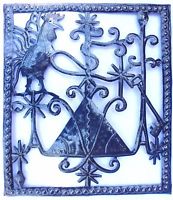Reading Veves
Last week, Casey sent me a letter from a customer, who was inquiring about the meaning of one of our veve sculptures. Veves, like this one at
the right, are symbols for Voodoo spirits, or loas. Each loa has a veve, and when the presence of a loa is required, a veve is drawn to act as an invitation to the loa to come to the Crossroads between the Natural World and the Spirit World.
The customer’s question was an interesting one, which I dug into with relish. However, after looking at several references, I found that many loas have two or more veves. Furthermore, this particular veve matched nothing that I had reviewed. Some of the lines of the piece writhe, snake-like, which could indicate Damballah, The Creator. The triangle at the bottom might further that possibility. Yet the rooster on the left is the favored animal of Papa Legba, The Protector. It is also favored by Ogun, The Guardian of Truth. Couldn’t this veve indicate either of those as well?
Curiouser and curiouser. I had to stop and think a bit. There was an answer somewhere, but I had come to the realization that I wasn’t going to find it in a book or online in black and white. I had to summon my inner Sherlock Holmes and use the available clues come to a logical solution.
First clue: Voodoo is not a religion with a book. No Koran, no Torah, no Bible and therefore no single set of rules. It is a religion based on oral tradition. Ever play “The Telephone Game” as a kid? The one where you start out with a single message and whisper it down the line and see how the message changes from beginning to end? Well if you did, you know what happens: Inevitably, some details get rearranged. That explains the variations on particular veves, of course. A variation, then. Maybe that’s what this is.
Second clue: Voodoo has hundreds of spirits. While there are a couple of dozen that are commonly invoked, dozens upon dozens more are only common in the vernacular. Like a local accent, they are recognized in small, localized areas and not by the entire body of Voodoo practitioners. It could be a fairly exact veve, but one that didn’t get on the academic (ethnographic? ethnographical??) radar because of it’s relative ideological isolation. A symbol for a minor spirit, then. Hmmmm….Maybe that’s what this is.
Third clue: The sculpture was created by an artist. Ever heard of artistic license? Sure you have. Artists take liberties all the time, bending their work to fit their own view of the world. It could be a an abstraction, a commentary, or even a synthesis of several veve symbols. An artistic interpretation, then. Ah, maybe THAT’S what this is.
So, Sherlock, what’s the the answer? Well, Watson, it could be anything. Maybe not a brilliant deduction on my part, but at least it’s honest. Guessing does no one any favors. Still, the possibilities are intriguing, are they not?
Contributed by Linda for It’s Cactus


![2691[1]](https://blog.itscactus.com/wp-content/uploads/2012/12/269112.jpg)
